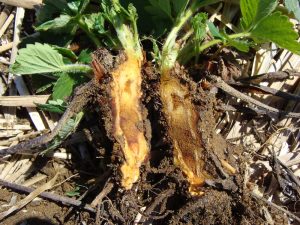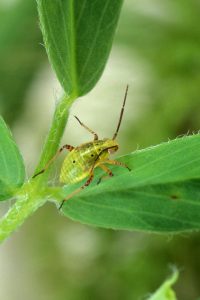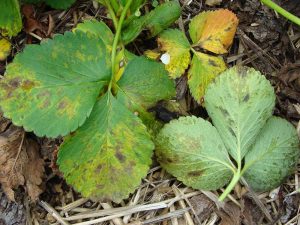Strawberry IPM Newsletter No. 1 – May 12, 2023

2023 STRAWBERRY PEST MANAGEMENT SEASON BEGINS
Vegetable and Berry Growers Twilight Meeting at Stevenson’s Farm, Wayne, June 6, 5:30 p.m.
Situation: Strawberry development this spring started off near normal, but recent hot weather has pushed blossom and emergence slightly ahead of normal. Fortunately, most fields were still under mulch when we had a warm spell in March, and had at least some snow cover during the very cold temperatures in February. I have seen moderate winter injury in some fields this spring, mostly in low areas, where mulch was blown off of the plants. Early flowering varieties such as Wendy, are showing a few blossoms in matted rows, and many are showing frost injury (black centers) from the cold nights earlier in the week. No frost warnings for the next week, but growers should still be vigilant and be prepared to frost-protect their plants, if necessary.
We have begun scouting strawberry fields for overwintering insect pests, disease issues and winter injury. The results of our strawberry scouting will be reported through this newsletter until harvest time. You can also get quick access to this information through the UMaine Highmoor Farm news blog at: https://extension.umaine.edu/highmoor/news-events/ or the UMaine Pest Management web page at https://umaine.edu/ipm/. If you have questions about the Newsletter, please give us a call at 933.2100 or send an e-mail message to me at: david.handley@maine.edu.
Spring Growers’ Twilight Meeting: The Maine Vegetable & Small Fruit Growers Association will be having a Spring Twilight Meeting on Tuesday, June 6, at 5:30 pm at Stevenson’s Strawberries, 271 Tucker Road in Wayne. The Stevenson’s specialize in strawberries but also grow a wide variety of vegetables for their stand and CSA.

Winter injury: Plants may be victims of winter injury if they appear weak or dead: especially in more exposed parts of a field, where mulch was not applied or where mulch was displaced by wind or animals. This is caused by freezing of the tissue in the crown of the plants, and therefore can be diagnosed by cutting into the crowns of the strawberry plants. The internal tissue will show dark brown discoloration. To reduce the impact of winter injury, make sure the plants get plenty of water, and apply nutrients to encourage root growth and flower development, which should include: nitrogen, calcium, and phosphorus. Heavy nitrogen fertilizer applications in the spring are not recommended, but up to 20 pounds of actual N (e.g. 125 lb. calcium nitrate) may improve early spring growth.
Spring Weed Management: Some growers were not able to make their typical dormant fall herbicide applications due to the early snowfall. Herbicides available for spring applications are much more limited due to concerns about plant injury and harvest intervals. Dacthal® and Devrinol® herbicides are registered for use in the spring and can be very effective on annual grasses and some broadleaf weeds, but only have pre-emergent activity, i.e. will not control weeds already emerged. Other herbicides have some post emergent activity but may only be applied with a shielded sprayer to the areas between the plant rows, not directly over the plants, or injury is likely to occur. These materials include Chateau®, Prowl H2O®, Satellite Hydrocap®, and Aim®.
Strawberry bud weevil: We have not observed any damage from “clippers” this week, but growers with fields in bloom should be on the lookout for this damage. Affected flower buds are clipped below the base and dangle from their stems looking wilted and brown. The small weevil can often be found within the flower clusters, laying eggs and feeding on pollen. Once the buds have opened these insects no longer cause significant injury. The control threshold for clipper injury is more than 1.2 clipped buds per two feet of row. Small holes in the petals of opening flowers indicates clipper feeding activity, and is often first noticed in the border rows. Expect clipper damage to be most common in later blooming varieties. Insecticide options for clippers include Brigade®, Bifenture®, Danitol®, Sevin XLR Plus® and PyGanic®. Clippers will also attack the buds of raspberries and blackberries, although they do not usually cause significant injury.

Tarnished plant bug activity has not yet been observed this season. The nymphs can be hard to find, especially if the plants are wet. Young nymphs are very small (2 mm), active, yellow-green insects. It is important to scout for them regularly, as they may appear very quickly as the weather improves. The threshold for plant bug nymphs is 4 or more flower clusters infested per 30 sampled. You don’t have to count the nymphs; just tap flower clusters over a plate or tray to knock any nymphs off. If any appear on the plate after tapping, count that cluster as “infested”. Start scouting any field with open flowers now. Insecticide options for tarnished plant bugs include malathion, Assail®, Brigade®, Bifenture®, Dibrom®, Danitol®, Closer® and PyGanic®.
White grubs: Weak growth noted in fields this spring may also be the result of white grubs feeding on the roots of newer plantings. These grubs are the larvae of beetles, including European chafer and Asiatic garden beetle. They differ from the larvae of black vine weevil and strawberry root weevil in that they have legs and a swollen anterior (rear end), and they tend to be larger. Their feeding weakens the plants by reducing the number of roots. The grubs can be found by pulling up weak plants and sifting through the soil that surrounds the roots. Controlling white grubs once they have become established in a field can be difficult. These tend to be more of a problem in new fields that have been planted following a grass rotation crop, because the adults prefer to lay their eggs in sod. Admire Pro® and Platinum® insecticides are labeled for control of white grubs and should be applied within two hours of irrigation or rainfall to be sure the chemical gets into the root zone. Admire Pro® requires a 14 day to harvest interval, while Platinum® requires a 50-day pre-harvest interval.
Cyclamen mites: I have seen some indications of cyclamen mite injury in fields this week, but it has not been widespread. Infested plants show weak growth and shrunken, crinkled leaves. These mites are very small and reside in the crown of the strawberry plant, feeding on the developing leaves and flower buds. They are very hard to see, even with magnification. Portal® miticide can be effective, but must be applied in lots of water to be sure that the material is carried down into the crowns where these mites reside.
Diseases: Bloom is a critical time to protect strawberry fruit against gray mold caused by the fungus Botrytis cinerea, especially when conditions have been damp. Two to three sprays of fungicide during bloom are typically required to provide good protection against this disease. Botrytis cinerea overwinters on old leaves and plant debris. Fruit infections take place almost exclusively through the flowers, so gray mold control efforts must be focused on the bloom period. If the bloom period is dry and/or good fungicide coverage is maintained, incidence of gray mold at harvest should be low.
There are several excellent fungicide choices for control of gray mold in strawberries. Elevate® (fenhexamid) has good to excellent activity against Botrytis. Captevate® is a pre-mix of captan and fenhexamid and has a broader spectrum of activity than Elevate® alone. Switch® (cyprodinil and fludioxonil), Scala® (pyramethanil) and Pristine® (pyraclostrobin and boscalid) are also excellent products for gray mold control. Topsin M® + captan is also a good fungicide combination, but remember that captan is strictly a protectant and can be washed off by rain or irrigation water. There has been some resistance developing to many of these products in the southern US, but so far all have worked well here in New England.
The fungicides Cabrio® (pyraclostrobin) and Abound® (azoxystrobin) are NOT suitable for gray mold control, but are effective against anthracnose and other fruit rot and leaf spot diseases. All fungicides mentioned above have a 0-day pre-harvest interval, except Topsin M® (1 day). Remember to alternate fungicides with different modes of action for resistance management purposes.

Angular leaf spot: I have seen some angular leaf spot in strawberries this week. This is a bacterial disease that is characterized by translucent leaf spots that may turn yellow and eventually black. The symptoms tend to start on the lower leaves but may move upwards as bacterial spores are splashed up by rain or irrigation water. Infection of the calyxes may result in a blackening of the berry stems and caps, reducing their marketability. Bacterial angular leaf spot is favored by extended cool, wet weather and nights with temperatures close to freezing. Frequent irrigation for frost protection can greatly encourage the development and spread of the disease, as will extended cool, damp weather. Susceptibility to this disease appears to vary significantly between varieties. The copper-containing material Kocide®, can reduce the spread of this disease. Start spray applications before bloom to prevent multiplication of the bacteria on the leaves before they jump to the berry caps. Application of copper sprays after bloom can result in fruit injury and is not recommended. Hydrogen dioxide (OxiDate®) may also have some activity against angular leaf spot when used on strawberries as part of a gray mold management program.
PFAS chemicals in pesticides: Some of the more prevalent pesticides used in berry crop production presently contain PFAS chemicals that have recently come under regulatory scrutiny due to potential health concerns. In Maine, recent legislation will forbid the use of these chemicals by 2030, and requires manufacturers to report all ingredients of their products, including PFAS chemicals in order to be registered in Maine. As a result, some companies have decided not to register their products in Maine this year. Among the most significant of these will be Entrust® and Delegate®, two spinosad products that have been widely used on berry crops for management of spotted wing drosophila. A similar product, Success®, is registered but is only labeled for strawberries among the berry crops, and is not OMRI approved. Any existing supplies of Entrust and Delegate can be used up. Some of the important pesticide products presently used on berries are known to contain PFAS chemicals. These products are still legal to use in Maine, and will remain so until 2030, unless present legislation changes. However, growers should consider customer acceptance of produce that has been exposed to PFAS chemicals, as this issue is becoming more prevalent in the media and is raising consumer awareness and concern.
Some of the more popular berry pesticide products that are known to contain PFAS chemicals include:
Fungicides:
Luna Tranquility®
Luna Sensation®
Flint®
Fontelis®
Procure®
Herbicides:
Aim EC®
Fusilade DX®
Solicam®
Goal 2XL®
Miticides/Insecticides:
Brigade®
Nealta®
Warrior III®
This list is not complete and is only intended to make growers aware of this issue. For more information about PFAS chemicals in pesticides, contact the Maine Board of Pesticides Control.
2022-2023 New England Small Fruit Management Guides is available online.
The best way to manage strawberry pests is to scout your own fields regularly and often. You should begin to scout as soon as flower buds emerge from the crowns and continue to monitor the plantings one or two times per week up until harvest.
Sincerely,
David T. Handley
Vegetable and Small Fruit Specialist
Highmoor Farm Pest Management Unit
P.O. Box 179 17 Godfrey Dr.
Monmouth, ME 04259 Orono, ME 04473
207.933.2100 1.800.287.0279
Where brand names or company names are used, it is for the reader’s information. No endorsement is implied nor is any discrimination intended against products with similar ingredients. Always consult product labels for rates, application instructions and safety precautions. Users of these producers assume all associated risks.
The University of Maine is an equal opportunity/affirmative action institution
